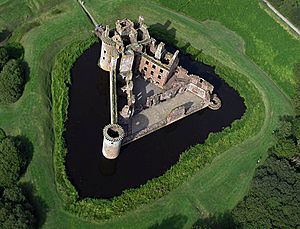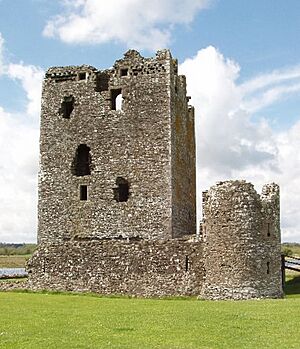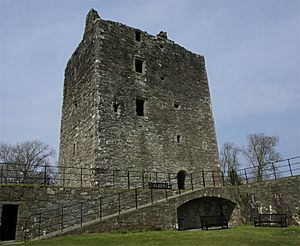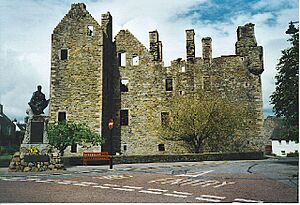List of castles in Dumfries and Galloway facts for kids
Dumfries and Galloway is a beautiful region in Scotland, famous for its many historic castles. These old buildings tell amazing stories about knights, kings, and everyday life long ago. From strong tower houses to grand courtyard castles, each one has its own unique history. Many of these castles were built to protect the land and its people. They show us how people lived and fought centuries ago in this part of Scotland.
Contents
Exploring Castles in Dumfries and Galloway
Dumfries and Galloway is home to a wide variety of castles. Some are still standing tall, while others are beautiful ruins. They were built for different reasons and in different styles. Let's explore some of the main types you can find here.
What is a Castle?
Castles were more than just big houses. They were strong forts built to defend land and people. Over time, their designs changed.
Tower Houses: Tall and Strong
Many castles in Dumfries and Galloway are tower houses. These were tall, strong buildings, often with thick walls. Families lived in them and used them for defense. They were popular from the 14th to 17th centuries. Some tower houses have special shapes, like an 'L' or a 'Z' when you look down from above. This made them even stronger against attacks.
Motte and Bailey Castles: Early Forts
The earliest castles were often motte and bailey castles. A motte is a big mound of earth, and the bailey is a fenced-off area next to it. A wooden tower would sit on top of the motte. These were quick to build but not as strong as stone castles.
Courtyard Castles: Big and Protected
Courtyard castles were much larger. They had strong walls surrounding a central open area, or courtyard. Inside the courtyard, there would be many buildings for living, cooking, and storage. These castles could hold many people and were very hard to attack.
Other Castle Types
You might also find Pele towers or Bastle houses. These were smaller, simpler fortified homes, often built near the border with England to protect against raids. A Baronial mansion is a large country house built in a castle-like style, but usually for comfort rather than defense.
Famous Castles to Discover
Dumfries and Galloway has some truly impressive castles. Many are open to visitors, letting you step back in time.
Caerlaverock Castle: A Unique Shape
Caerlaverock Castle is one of Scotland's most famous castles. It's a courtyard castle from the 13th century. What makes it special is its unique triangle shape! It's now a ruin but is well-preserved by Historic Scotland. You can explore its walls and imagine life there long ago.
Threave Castle: Island Fortress
Threave Castle is a 14th-century tower house built on an island in the River Dee. It was once a very important stronghold. You can only reach it by a small boat, which makes visiting it an adventure! It's also looked after by Historic Scotland.
Drumlanrig Castle: A Grand Home
Drumlanrig Castle is not an old ruined fort. It's a grand Renaissance house built in the 17th century. It stands on the site of an even older castle. This beautiful building is still a private home today for the Duke of Buccleuch. It has amazing gardens and art.
Cardoness Castle: A Strong Tower
Cardoness Castle is a 15th-century tower house. It's a ruin now but is very well-preserved. You can climb its stairs and explore its rooms. It gives a great idea of what a strong family home looked like centuries ago. Historic Scotland cares for it.
MacLellan's Castle: A Town Castle
MacLellan's Castle is a 16th-century tower house right in the town of Kirkcudbright. It was built like a grand town house but with defenses. It's now a ruin but still impressive. It's also looked after by Historic Scotland.
Castles Still Standing and Lived In
It's amazing to think that some of these ancient castles are still homes today!
- Abbot's Tower is a 16th-century L-plan tower house. It was restored in the 1990s and is now a private home.
- Amisfield Tower (also called Hempisfield Tower) is a 17th-century tower house. It's still used as a home today.
- Barholm Castle is a 15th-century tower house. It was restored and is now a private residence.
- Barscobe Castle is a 17th-century L-plan tower house. It was restored in 1971 and is a private home.
- Bonshaw Tower is a 16th-century oblong plan tower house. It has been preserved and is a private home.
- Closeburn Castle is a 14th-century tower house. It is still used as a residence today.
- Comlongon Castle is a 15th-century tower house. It has been restored and is now a hotel.
- Gilnockie Tower (also known as Hollows Tower) is a 16th-century oblong plan tower house. It has been restored and is a private home.
- Hills Tower is a 16th-century oblong plan tower house. It was restored around 1930 and still has its original outer wall, called a barmkin.
- Isle of Whithorn Castle is a 17th-century tower house. It is preserved and used as a residence.
- Kirkconnell Tower is a 15th-century tower house. It is still used as a private home.
- Lochhouse Tower is a 16th-century oblong plan tower house. It has been restored and is a private home.
- Lochinch Castle is a large Baronial house from 1867. It is still used as a residence today.
- Orchardton Castle is an 18th-century Baronial Mansion that is still a private residence.
Castles in Ruin
Many castles are now ruins, but they still hold a lot of history and charm.
- Auchen Castle is a 14th-century courtyard castle that is now a ruin.
- Auchenrivock Tower is a late 16th-century L-plan tower house that is ruined.
- Auchenskeoch Castle is a 17th-century Z-plan tower house and is now a ruin. It's the only Z-plan tower in Galloway.
- Baldoon Castle is a 17th-century tower house that is now a ruin.
- Balmangan Tower is a 16th-century oblong plan tower house that is ruined.
- Blackethouse Tower is a 16th-century oblong plan tower house that is ruined.
- Blacklaw Tower is a 16th-century oblong plan tower house that is ruined.
- Breckonside Tower is a late 16th or early 17th-century Pele tower that is ruined.
- Brydekirk Tower is a 16th-century tower house that is ruined.
- Buittle Castle is a 12th-century castle that is now a ruin.
- Carsluith Castle is a 16th-century tower house that is now a ruin.
- Castle Kennedy is a 14th-century tower house that is now a ruin. It's in the beautiful grounds of Lochinch Castle.
- Cornal Tower is a 16th-century oblong plan tower house that is ruined.
- Corsewall Castle is a 15th-century castle that is now a ruin.
- Crawfordton Tower is a trapezoid plan tower house that is ruined.
- Cruggleton Castle is a 12th-century motte and bailey castle that is now a ruin.
- Cumstoun Castle is an oblong plan tower house from around 1500 that is ruined.
- Dalswinton Tower is an early 16th-century Z-plan tower house that is ruined.
- Dumfries Castle is a 12th-century castle that is now a ruin.
- Dundeugh Castle is a 16th-century L-plan tower house that is ruined.
- Dunskey Castle is a 16th-century tower house that is ruined.
- Earlstoun Castle is a 16th-century L-plan tower house that is decayed but its roof is maintained.
- Edingham Castle is a 16th-century oblong plan tower house that is ruined.
- Frenchland Tower is a late 16th or early 17th-century oblong plan tower house that is ruined.
- Gillesbie Tower is a 16th-century oblong plan tower house that is ruined.
- Glenae Tower is a 16th-century tower house that is ruined.
- Lag Tower is an oblong plan tower house that is ruined.
- Langholm Tower is a 16th-century tower house that is ruined.
- Lochar Tower is a 16th-century rectangular plan tower house that is ruined.
- Lochwood Castle (also known as Lochwood Tower) is a 15th-century L-plan tower house that is ruined.
- Mellingshaw Tower is a 16th-century tower house that is ruined.
- Morton Castle is a 15th-century courtyard castle that is ruined.
- Mouswald Tower is an oblong plan tower house from around 1562 that is ruined.
- Orchardton Tower is a 15th-century tower house that is ruined.
- Plunton Castle is a Tower House that is ruined.
- Raecleugh Tower is a Bastle house that is ruined.
- Sanquhar Castle is a 15th-century courtyard castle that is ruined.
- Sorbie Tower is a 16th-century tower house that is ruined.
- Torthorwald Castle is a 14th-century oblong plan tower house that is ruined.
- Wreaths Tower is a tower house from before the 16th century that is now a ruin.
Castles with Few Remains
Some castles have almost disappeared over time, leaving only small traces or nothing at all.
- Annan Castle from the 12th century now only has motte remains.
- Castlemilk Tower was a 15th-century tower house that was demolished around 1707.
- Corra Castle, Kirkgunzeon only has remains of a 17th-century house.
- Dumfries Castle from the 12th century is now a ruin with no visible remains.
- Kirkcudbright Castle was a 12th-century motte and bailey castle. The Greyfriar's Church was built on its site.
- Lockerbie Tower was a 16th-century oblong plan tower house that was demolished in 1967. The site is now a police station.
- Newbie Castle was a 15th-century tower house demolished in 1816, with only small remains left.
- Old Lochmaben Castle was a 12th-century motte and bailey castle. Only earthworks remain today. It might even be the birthplace of Robert the Bruce!
- Staplegorton Castle was a 12th-century Motte and Bailey castle, but no remains are left.
- Tibbers Castle (or Mote de Tibris) was a 13th-century Motte and bailey castle, but no remains are left.
- Wauchope Castle was a 13th-century castle, but no remains are left.
- Wigtown Castle was a 12th-century castle, but no remains are left.
Images for kids
See also
- Castles in Scotland
- List of castles in Scotland
- List of listed buildings in Dumfries and Galloway









